Spanish Royal Guard
| Royal Guard Guardia Real | |
|---|---|
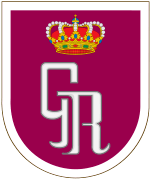 | |
| Active |
1504–1931 1949-present[1] |
| Country |
|
| Allegiance | King and Fatherland |
| Branch |
|
| Type | Infantry, cavalry and horse artillery |
| Role |
Executive protection Foot Guards Honor guard |
| Size | 1900 troops (1 regiment) |
| Garrison/HQ | Royal Palaces |
| Motto(s) |
Al servicio de la Corona ("At the service of the Crown") |
| March |
Himno de la Guardia Real ("Hymn of the Royal Guards") |
| Anniversaries | October 12 |
| Commanders | |
| Notable commanders |
General Prim General Castaños |
The Royal Guard (Spanish: Guardia Real) is an independent regiment of the Spanish Armed Forces that is dedicated to the protection of the King of Spain and members of the Spanish Royal Family. It currently has a strength of 1900 troops. While the guard does participate in parades and other ceremonial events, it is a fully functional combat unit. Its members are recruited from the ranks of all three branches of the Spanish Armed Forces and receive the same combat training as regular soldiers.
The guard contains a diverse mix of units: a Royal Marines company from the Navy, a paratroop company from the Air Force and an infantry company from the Army, among others. Some units have served in recent times in Afghanistan and Bosnia.
History
The history of the Royal Guard dates back to medieval times. The senior unit and one of the oldest body guards in the world is the Corps of Gentlemen of the Chamber, the Monteros de Espinosa, dating to 1006 and created by Sancho Garcia of the House of Castile.
Even before the time of the first monarch of Spain, the catholic kings formed the group called the Old Guards of Castile (Guardias Viejas de Castilla). Later on, the first monarch of Spain, Charles V ordered that a company of those guards to guard & reside in his palace, denominating it The Hundred Contines (Los Cien Continos)
Official formation
Later on, Charles V's father, Philip the Handsome arrived in Spain in 1502 brought with him his "Archers of Burgundy" aka "of the Blade". These group of Royal Guards with their Burgundian style will remain in service until the reorganization of the "Troops of Royal House" (Tropas de Casa Real) by Felipe V.
Civil War
The guards were disbanded in 1931 as a result of the formation of the 2nd Republic & was replaced by the cavalry unit, the "Presidential Escort Squadron" (Escuadrón de Escolta Presidencial). By 1936, it included the "Presidential Guard Battalion” (batallón de Guardia Presidencial), which remained loyal to the Republic during the civil war.
Restoration
Under Francisco Franco, By Decree of February 4, 1949, the Military House of the Generalissimo was reorganized & formed “the Regiment of the Guard of His Excellency the Head of State” (Regimiento de la Guardia de Su Excelencia el Jefe del Estado). After several reorganization, the unit would last until Franco's death.
Upon Franco’s death & the ascension of King Juan Carlos as the head of state, the former "Regiment of the Guard of S.E. the Generalissimo" (Regimiento de la Guardia de S.E. el Generalísimo) was integrated into the new army under the king & formed the "Regiment of the Royal Guard" (Regimiento de la Guardia Real); the modern day Guardia Real. [2]
Role
In addition to protecting members of Spanish Royal Family, the present functions of the unit include the protection of foreign heads of state visiting Spain, and of royal palaces such as the Royal Palace of Madrid (Palacio Real), the Palace of El Pardo and the Palace of Zarzuela.
They are also an active combat unit & have been deployed to Bosnia & Afghanistan.
Organization
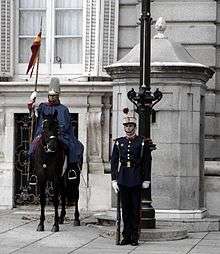

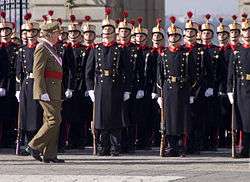
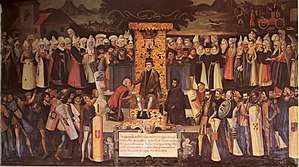
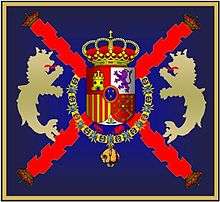
- High Command of the Royal Guard
- High Command Group
- Group HQ
- HQ Company
- Security Company
- Communications Company
- Formation Center
- Religious Service of the Royal Guard
- Escorts Group
- Group HQ
- Military Control Company
- Perimeter Control Section
- Attack Dog Section
- Motorcycle Section
- Alabarderos (Halberdiers) Company
- 1st Immediate Security Section
- 2nd Immediate Security Section
- Alabarderos Section
- Royal Escort Squadron
- Mounted Band of Timpani and Bugles
- Mounted Marker Squad
- Cuirassiers Troop
- Lancers Troop
- Royal Horse Artillery Battery
- Equestrian Training Unit
- Honors Group
- Group HQ
- Army Company "Monteros de Espinosa"
- 1st Platoon
- 2nd Platoon
- 3rd Platoon
- Drill Team Platoon
- Navy and Marine Composite Company "Mar Océano"
- 1st Platoon
- 2nd Platoon
- 3rd Platoon
- Air Force Squadron "Plus Ultra"
- 1st Flight
- 2nd Flight
- 3rd Flight
- Mountaineering Group
- Diving Unit
- Logistics Group
- Group HQ
- Administration Company
- Maintenance Company
- Transportation Company
- Logistics Directorates
- Musical Unit of the Armed Forces Royal Guard
- Musical Unit HQ and High Command
- Military Band of the Royal Guard of Spain
- Corps of Drums of the Royal Guard (Drums and bugles)
- Fife Section and Pipe band
- Brass band of the Royal Guard
- Royal Guard Big band
- Royal Guard Chamber Ensembles
See also
References
External links
| Wikimedia Commons has media related to Spanish Royal Guard. |
- Official website of the Royal Guard (in Spanish)